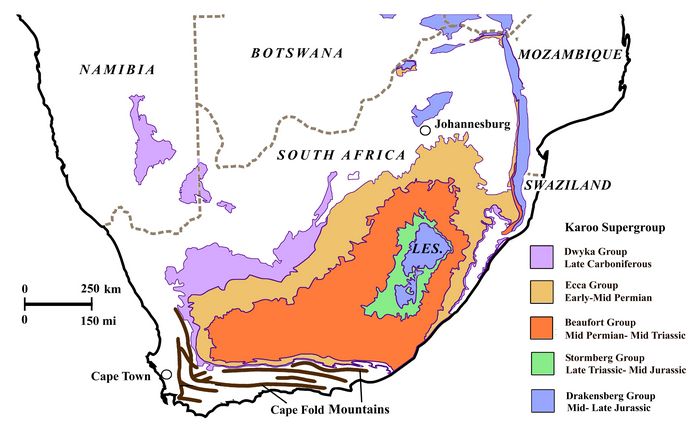Athena Review Image Archive ™
Karoo Basin geology, South Africa

Karoo Basin geology in South Africa (after Rubridge 1995)
The
Karoo
Basin in South Africa contains a 1500 km-wide succession of
five geological formations (Dwyka, Ecca, Beaufort, Stormbert, and
Drakensberg), dating from
the Late Carboniferous through Jurassic periods.
Within this vast area, the third of these formations, the Beaufort Group (orange in figure) is the lowest terrestial formation, overlying shallow marine shales of the Ecca Group. Beaufort Group rocks consist of shales and sandstones that represent riverine deposits of an ancient sedimentary basin. This basin is bounded on the south by the Cape Fold Mountains, which were uplifted in the Early to Middle Permian period by tectonic plates converging on those of South Africa (Rubridge 1995), providing exposure of fossil-rich formations to the north.
The importance of the Beaufort Group for paleontology stems from its having provided a comprehensive series of often well-preserved fossil zones, including a continuous record of flora and fauna dating from the Middle Permian through Middle Triassic periods, dating from 270-220 mya (Rubridge 1995).
Fossil evidence of Therapsids ("beast faces"), the ancestors of mammals, first appear in the Middle Permian deposits of the Beaufort Group. Three suborders of Therapsids include the Anomodontia ("undefined teeth"), the Dinocephalians ("terrible heads"), and the Theriodonta ("beast teeth").
The
Theriodonts became one of the two synapsid survivors of the great
Permian–Triassic extinction event at 252 mya, the other being the
dicynodonts ("two dog teeth"), part of the Anomodontia. Theriodonts
split into two groups, Therocephalians ("beast heads") who died out
after the Early Triassic, and cynodonts ("dog teeth"), whose
carnivorous forms became progressively smaller during the Triassic. By
the Late Triassic the first mammals evolved from small, shrew-sized
cynodonts called trithelodonts.
The Beaufort group has been
subdivided into eight faunal assemblage zones, each associated with one
or more local geological formations, and each containing a number of
associated taxa from the Permian and Triassic periods, and named for a
dominant genus: 1. Eodicynodon; 2. Tapinocephalus; 3.
Pristerognathus; 4. Tropidostoma; 5.
Cistecephalus; 6. Dicynodon; 7. Lystrosaurus; 8.
Cynognathus .
Reference:
Rubridge, B.S. (ed.) 1995. Biostratigraphy of the Beaufort Group. South African Commission on Stratigraphy, Biostratigraphic Series 1, pp.1-45.
Copyright © 1996-2020 Rust Family Foundation (All Rights Reserved).